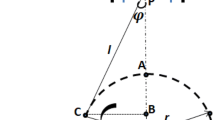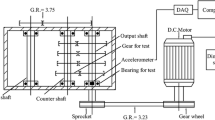Abstract
Diagnosis of engine component faults is a challenging task for every researcher due to the complexity involved in the engine operations. The developed faults on the engine components subsequently reduce their performance and cause higher maintenance costs. Hence, an effective condition monitoring technique should be implemented to diagnose engine component faults. Therefore, in this work, potential fault diagnosis techniques are presented to detect and diagnose the scuffing faults developed on the diesel engine components. Condition monitoring techniques such as vibration and acoustic emission analyses were employed to acquire the fault-related signals. These signals were analyzed in the time-domain, frequency-domain, and time–frequency domain using signal processing methods viz. fast Fourier transform (FFT) and short-time Fourier transform (STFT). The statistical feature parameters were also extracted from the acquired signals to diagnose the severity of the faults. Further, the artificial neural network (ANN) models were developed to predict and classify the scuffing faults developed on the engine components. The results showed that the FFT and STFT techniques provide better fault diagnostic information. The developed neural network models have effectively classified the scuffing faults on engine components with an accuracy of 100%.














Similar content being viewed by others
Abbreviations
- ANN:
-
Artificial neural network
- \(b_{k}\) :
-
Bias to ANN
- c :
-
Damping coefficient
- C :
-
Sound velocity (\(\text m/s\))
- g :
-
Acceleration due to gravity (\(\text m/s^{2}\))
- FFT:
-
Fast Fourier transform
- f :
-
Frequency parameter (Hz)
- I :
-
Basic input
- \(I_\text{min}\) :
-
Minimum value from input
- \(I_\text{max}\) :
-
Maximum value from input
- \(I_\text{norm}\) :
-
Normalized value
- k :
-
Stiffness of system
- MLP:
-
Multilayer perceptron
- m :
-
Mass of the system (kg)
- N :
-
Total number of samples
- \(O_{i}\) :
-
Predicted output value
- STFT:
-
Short-time Fourier transform
- S :
-
Emission area (\(\text m^{2}\))
- t :
-
Time parameter (\(\text s\))
- \(T_{i}\) :
-
Target value
- \(u_{k}\) :
-
Output at neuron
- \(\bar{V}\) :
-
Spatial mean of vibration velocity
- \(W^{*}\) :
-
Windowing function
- \(w_{kj}\) :
-
Weights assigned to neuron
- W :
-
Sound pressure level (dB)
- \(x_{i}\) :
-
Measured data
- \(x_{j}\) :
-
Input to ANN
- \(\bar{x}\) :
-
Mean value of the signals
- x(t):
-
Time-domain data
- x :
-
Displacement (\(\text m\))
- \(\dot{x}\) :
-
Velocity (\(\text m/s\))
- \(\ddot{x}\) :
-
Acceleration (\(\text m/s^{2}\))
- \(y_{k}\) :
-
Output at neuron
- \(\tau\) :
-
Time variable
- \(\omega\) :
-
Rotational frequency (\(\text rad/s\))
- \(\sigma\) :
-
Standard deviation
- \(\phi\) :
-
Activation function
- \(\delta\) :
-
Downward displacement (\(\text m\))
- \(\rho\) :
-
Specific mass (\(\text kg/m^{3}\))
- \(\sigma _{rad}\) :
-
Radiation efficiency
References
Vernekar K, Kumar H, Gangadharan KV (2018) Engine gearbox fault diagnosis using machine learning approach. J Qual Maint Eng 24(3):345–357
Moosavian A, Najafi G, Ghobadian B, Mirsalim M, Jafari SM, Sharghi P (2016) Piston scuffing fault and its identification in an IC engine by vibration analysis. Appl Acoust 102:40–48
Moosavian A, Najafi G, Ghobadian B, Mirsalim M (2017) The effect of piston scratching fault on the vibration behavior of an IC engine. Appl Acoust 126:91–100
Taghizadeh-Alisaraei A, Ghobadian B, Tavakoli-Hashjin T, Mohtasebi SS, Rezaeiasl A, Azadbakht M (2016) Characterization of engine’s combustion-vibration using diesel and biodiesel fuel blends by time–frequency methods: a case study. Renew Energy 95:422–432
Taghizadeh-Alisaraei A, Ghobadian B, Tavakoli-Hashjin T, Mohtasebi SS (2012) Vibration analysis of a diesel engine using biodiesel and petrodiesel fuel blends. Fuel 102:414–422
Taghizadeh-Alisaraei A, Rezaei-Asl A (2016) The effect of added ethanol to diesel fuel on performance, vibration, combustion and knocking of a CI engine. Fuel 185:718–733
Çelebi K, Uludamar E, Tosun E, Yıldızhan Ş, Aydın K, Özcanlı M (2017) Experimental and artificial neural network approach of noise and vibration characteristic of an unmodified diesel engine fuelled with conventional diesel, and biodiesel blends with natural gas addition. Fuel 197:159–173
Jena DP, Panigrahi SN (2014) Motor bike piston-bore fault identification from engine noise signature analysis. Appl Acoust 76:35–47
Hosseini SH, Taghizadeh-Alisaraei A, Ghobadian B, Abbaszadeh-Mayvan A (2020) Artificial neural network modeling of performance, emission, and vibration of a CI engine using alumina nano-catalyst added to diesel-biodiesel blends. Renew Energy 149:951–961
Xu X, Zhao Z, Xu X, Yang J, Chang L, Yan X, Wang G (2020) Machine learning-based wear fault diagnosis for marine diesel engine by fusing multiple data-driven models. Knowl Based Syst 190:105324
Wu JD, Liu CH (2008) Investigation of engine fault diagnosis using discrete wavelet transform and neural network. Expert Syst Appl 35(3):1200–1213
Jafari SM, Mehdigholi H, Behzad M (2014) Valve fault diagnosis in internal combustion engines using acoustic emission and artificial neural network. Shock Vib. https://doi.org/10.1155/2014/823514
Shatnawi Y, Al-Khassaweneh M (2013) Fault diagnosis in internal combustion engines using extension neural network. IEEE Trans Ind Electron 61(3):1434–1443
Ahmed R, El Sayed M, Gadsden SA, Tjong J, Habibi S (2014) Automotive internal-combustion-engine fault detection and classification using artificial neural network techniques. IEEE Trans Veh Technol 64(1):21–33
Ayati M, Shirazi FA, Ansari-Rad S, Zabihihesari A (2020) Classification-based fuel injection fault detection of a trainset diesel engine using vibration signature analysis. J Dyn Syst Meas Control 142(5):051003
Hou L, Zou J, Du C, Zhang J (2019) A fault diagnosis model of marine diesel engine cylinder based on modified genetic algorithm and multilayer perceptron. Soft Computing. https://doi.org/10.1007/s00500-019-04388-3
Ravikumar KN, Kumar H, Kumar GN, Gangadharan KV (2020) Fault diagnosis of internal combustion engine gearbox using vibration signals based on signal processing techniques. J Qual Maint Eng. https://doi.org/10.1108/JQME-11-2019-0109
Shiblee M, Yadav SK, Chandra B (2017) Fault diagnosis of internal combustion engine using empirical mode decomposition and artificial neural networks. In: International conference on intelligent computing, pp 188–199
Ramteke SM, Chelladurai H, Amarnath M (2019) Diagnosis of liner scuffing fault of a diesel engine via vibration and acoustic emission analysis. J Vib Eng Technol 8:815–833
Huston R, and Liu C (2011) Principles of vibration analysis with applications in automotive engineering. SAE. Warrendale, pp i–xiv
Dyson A (1975) Scuffing—a review. Tribol Int 8(2):77–87
De Luca JC, Gerges SN (1996) Piston slap excitation: literature review (No. 962395). SAE Technical Paper
Owens FJ, Murphy MS (1988) A short-time Fourier transform. Signal Process 14(1):3–10
Li W, Gu F, Ball AD, Leung AYT, Phipps CE (2001) A study of the noise from diesel engines using the independent component analysis. Mech Syst Signal Process 15(6):1165–1184
Celebi K, Uludamar E, Özcanlı M (2017) Evaluation of fuel consumption and vibration characteristic of a compression ignition engine fuelled with high viscosity biodiesel and hydrogen addition. Int J Hydrog Energy 42(36):23379–23388
Author information
Authors and Affiliations
Corresponding author
Ethics declarations
Conflict of Interest
On behalf of all authors, the corresponding author states that there is no conflict of interest.
Additional information
Publisher's Note
Springer Nature remains neutral with regard to jurisdictional claims in published maps and institutional affiliations.
Rights and permissions
About this article
Cite this article
Ramteke, S.M., Chelladurai, H. & Amarnath, M. Diagnosis and Classification of Diesel Engine Components Faults Using Time–Frequency and Machine Learning Approach. J. Vib. Eng. Technol. 10, 175–192 (2022). https://doi.org/10.1007/s42417-021-00370-2
Received:
Revised:
Accepted:
Published:
Issue Date:
DOI: https://doi.org/10.1007/s42417-021-00370-2




